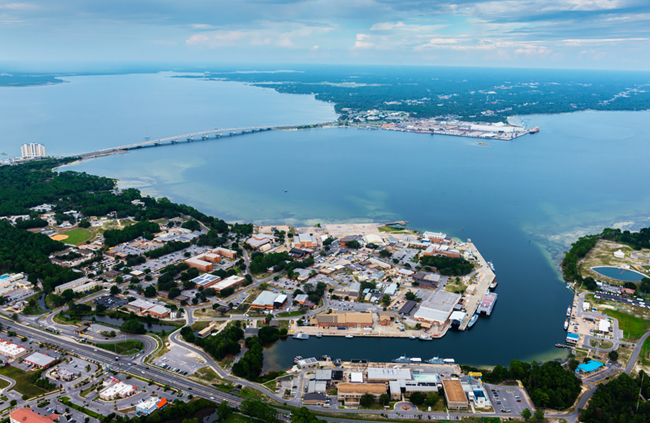Military
Naval Support Activity – Panama City

Currently, the Activity hosts several project offices, including the Deployable Joint Command and Control System. NSA, Panama City also hosts many other diverse tenant activities: Explosive Ordnance Disposal Detachment, U.S. Coast Guard, Florida Fish and Wildlife Conservation Commission, Naval Dental Center Branch Dental Clinic, Navy Exchange Branch, Naval Hospital Pensacola Branch Clinic, Naval Criminal Investigative Service, Navy Publication and Printing Service Office, Naval Special Warfare Training Detachment, Personnel Support Detachment, Resident Officer in Charge of Construction, Veterans Administration Primary Care Clinic, and the Coastal Operations Institute.
The Activity totals 657 acres and houses 221 buildings. The Athena Research Vessels are based in Panama City, and include three converted Asheville-class patrol gunboats. Two have been converted to support general hydrodynamic and acoustic testing, and one supports electromagnetic signatures testing.
NSA, Panama City employs approximately 2,800 civilian and military personnel with an annual payroll of more than $150 million. The Activity contracts services, buys local goods, and maintains an active construction program. Its economic impact on Bay County is more than $400 million annually. Throughout its existence, NSA, Panama City and its tenants have continued to evolve to meet the demanding requirements of the U.S. Navy-to defend today and to plan for tomorrow in response to national needs.
History
Naval Support Activity, Panama City had its origin in the mine countermeasures research conducted during World War II at the U.S. Naval Mine Warfare Test Station, Solomons, Maryland. In 1945, equipment, facilities, and personnel were transferred from Solomons to Panama City, Florida, to occupy a 373-acre tract along St. Andrew Bay. This same tract was used as a Naval Section Base in 1942, the U.S. Naval Amphibious Training Base in 1944, and was inactivated in June 1945. It was established as the U.S. Navy Mine Countermeasures Station July 20, 1945. By 1955, the Countermeasures Station had achieved laboratory status and was renamed to the U.S. Navy Mine Defense Laboratory in April 1955. Its mission had been expanded to include torpedo countermeasures, helicopter mine countermeasures, mine hunting and mine watching study projects, and other advanced countermeasures. Also by the late 1950’s the laboratory started dive programs as well.
The Laboratory became an activity of the Naval Ship Research and Development Center, Carderock, Maryland, November 1967, and was renamed the Naval Ship Research and Development Laboratory, Panama City, November 1968. A naval internal reorganization effort to combine several of the closely related research and development laboratories resulted in the Panama City and Annapolis labs being combined with the David Taylor Naval Ship Research and Development Center at Carderock, MD. Renamed the Naval Coastal Systems Laboratory in February 1972, its mission had expanded into warfare areas such as inshore undersea warfare and amphibious operations. In its separate command status, the laboratory reported directly to the Chief of Naval Material. Navy Experimental Diving Unit (NEDU) became a tenant in 1973, established to perform all aspects of independent test and evaluation for diving and hyperbaric operation. In 1974, the Naval Diving and Salvage Training Center moved to the base from the Washington Navy Yard to provide all aspects of training in diving, ship salvage, and submarine rescue. These tenants, combined with the diving research and development program of the host laboratory, established Panama City as the single site for diving for the Navy.
March 1978, again a name changed to place changing the base to Naval Coastal Systems Center (NCSC) to more accurately reflect the broad range of products and services provided and to bring its name into consonance with the other seven RDT&E centers commanded by the Chief of Naval Material. Upon disestablishment of the Naval Material Command in 1985, NCSC reported to the Office of the Chief of Naval Research. From 1986 through 1991, NCSC reported to the Space and Naval Warfare Systems Command. In October 1991, it was realigned under the Naval Sea Systems Command. In January 1992, NCSC was re-designated the Coastal Systems Station (CSS), Dahlgren Division, Naval Surface Warfare Center, reporting to the Naval Sea Systems Command. On October 1 2003, CSS was reorganized as a part of the alignment under the Commander, Navy Installations. During this reorganization, the base was renamed Naval Support Activity, Panama City, reporting to the Commander, Navy Region Southeast. The R&D mission workforce was renamed the Naval Surface Warfare Center, Panama City. The primary mission and work areas of the base remained unchanged.
NSA, Panama City’s largest tenant activity is NSWC PC, still one of the major research, development, test and evaluation laboratories of the Navy, which boasts a wide base of expertise in engineering and scientific disciplines in the mission areas of mine warfare, expeditionary warfare, special warfare, and diving and life support. NSWC PC and the other three major tenants, the Navy Experimental Diving Unit, the Naval Diving and Salvage Training Center, and the Center for Navy Ordnance Disposal and Diving, make the Station the consolidated site for all navy diving and salvage research, development, testing, and training. Please visit the site http://www.navsea.navy.mil/nswc/panamacity/default.aspx for more information about the NSA-Panama City Base.
Tyndall Air Force Base
History
The 325th Fighter Wing was activated at Tyndall Air Force Base, Fla., on 1 July 1981 as the 325th Fighter Weapons Wing, adopting the emblems, awards and history of its predecessor, the 325th Fighter Group, the “Checkertail Clan” of World War II fame. On 15 October 1983, the wing was re-designated the 325th Tactical Training Wing, and assumed its air superiority training responsibilities as part of the United States Air Force Air Defense Weapons Center. The wing began receiving the F-15 Eagle in April 1984. When the United States Air Force Air Defense Weapons Center was inactivated 12 September 1991, the wing assumed the role as installation host under Tactical Air Command. On 1 October 1991, HQ USAF re-organized the wing as an objective wing and re-designated it as the 325th Fighter Wing. In June 1992, the wing transferred to Air Combat Command, before settling in Air Education and Training Command in July 1993. In May 1996, U. S Air Force officials at the Pentagon announced that Tyndall would host the F/A-22 air superiority fighter, the Air Force’s next generation fighter jet. In October 2002, USAF activated the 43rd Fighter Squadron as the first unit in the Air Force to fly the F/A-22 Raptor. A year later, Lieutenant Colonel Jeffery Harrigian delivered the first F/A-22 from factory to Tyndall AFB. In December 2005, the Raptor achieved initial operational capability and was declared operational by Gen Ronald E. Keys, ACC commander. The F/A-22 was re-designated as the F-22A. Raptor training began normalizing in March 2008 when the first F-22 Basic Course began with four new lieutenants constituting a small group try out (SGTO). All four successfully graduated on 31 October 2008. As the 325th Fighter Wing moved into 2009, it prepared for a new chapter in its history with the discussions concerning the future of F-15 training taking center stage. For now, the Checkertails still graduate the best Raptor pilots, Eagle pilots, and Air Battle Managers in the world.
 Click HERE to view Tyndall news and announcements. Information and graphic gathered from http://www.tyndall.af.mil/. Please visit the site provided for more information about Tyndall Air Force Base, or visit http://www.af.mil/.
Click HERE to view Tyndall news and announcements. Information and graphic gathered from http://www.tyndall.af.mil/. Please visit the site provided for more information about Tyndall Air Force Base, or visit http://www.af.mil/.
Bay Defense Alliance
Bay Defense Alliance Quaterly Update In response to the growing emphasis on the downsizing of US military infrastructure and the enactment of federal Base Realignment and Closure legislation calling for closure initiatives in 1991, 1993 and 1995, the Bay County BRAC Committee, Inc. was formed. The organization became an independent, not for profit corporation and later changed its name to the Bay Defense Alliance, Inc. The organization was founded by community leaders involved with the Bay County Chamber of Commerce, the Bay County Economic Development Alliance and other key organizations, and the 25-member board includes representation from nearly every major community organization.
Since its inception, the mission of the BDA has been to study every aspect of our military installations and work to preserve and enhance their missions and military value. Working closely with our congressional delegation toward this common goal, the BDA has assisted our installations in securing appropriate funding necessary to sustain operations, ensure growth and complete important military construction projects.
The Bay Defense Alliance also partners with Enterprise Florida, Inc., and the Florida Defense Alliance to make Florida a more defense-friendly state. The BDA works closely with installation leadership to facilitate the Defense Infrastructure Grant program which provides funding for special projects of mutual benefit to our local bases and the community. To date the Defense Infrastructure Grant Program has brought more than $4.5 million in grants to Tyndall AFB and the Naval Support Activity Panama City.
Although legislated BRAC law is now in the phase of implementing decisions, the threat has not diminished. Competition for defense dollars will continue, installations that contribute to our national defense will remain strong and efficient only with the full support of the communities around them and the capable involvement of our elected leadership. Accordingly, the roles of the Bay Defense Alliance and the Florida Defense Alliance are more important than ever in this effort. Please go to www.baydefense.org for more information.